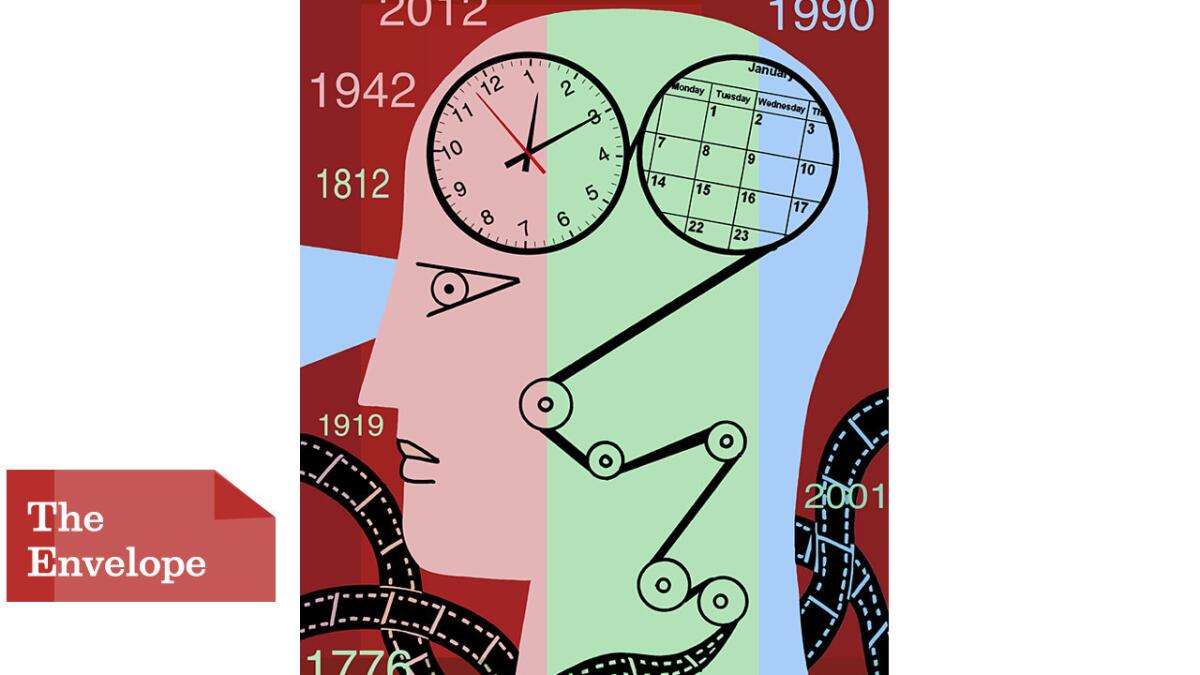The Envelope: In movies such as ‘Boyhood’ and ‘Interstellar,’ time is of the essence

- Share via
In a startling array of this year’s films, the dimension of time has become almost a special effect. “Birdman” and “Locke” push long camera shots to their limit. “Interstellar” skips decades in a flash, while “Get On Up” dices more than 50 years into little pieces. “Boyhood” takes years to watch a boy grow up; “Fury” distills its coming-of-age story into one ferocious day. In each case, the manipulation of time is so integral to the plot it’s practically a character in itself.
“Locke” writer-director Steven Knight focuses our gaze on Ivan Locke (Tom Hardy), a man trapped in his car by conflicting forces as he races toward an unknown destiny. The film is essentially one long scene shot in real time; Hardy performed the entire script for each take.
“Birdman” has also been hailed for taking place in one apparent long shot. But while accomplishing that feat, the writers also had to play fast and loose with the concept of time in order to make that one shot move smoothly through every transition.
“We understood that we needed to play a little bit with time to achieve this better rhythm, and to allow ourselves to push the story forward,” said Nicolás Giacobone, who wrote “Birdman” with Alexander Dinelaris, Armando Bo and director Alejandro G. Iñárritu. “You never know if what you’re looking at belongs to [lead character] Riggan’s interpretation or belongs to reality, and in the end it doesn’t matter. The important thing in the movie is not to realize which scene or moment belongs to which consciousness, it’s that you go into this weird, strange narration where time is broken up completely.”
“Fury” writer-director David Ayer also knew early on that he would be using one day to frame the story (as he did for his film “Training Day”). An entire war is captured between two sunrises, and a boy becomes a man in unexpected ways. “I feel like encapsulating it within a 24-hour period really shines a stark light on how much he changed,” Ayer said.
It took writer-director Richard Linklater two years to figure out how to corral the disparate moments that make up a boy’s life. He almost gave up when it suddenly occurred to him to film that life as it progressed in reality. So he gathered his cast for a few days a year, over 12 years, and filmed the story in real time, as it were.
In its look at 55 years in the life of James Brown, “Get On Up” doesn’t employ flashbacks — it sets off flashes in every direction. The script, by Jez and John-Henry Butterworth, already used scenes out of chronological sequence, which appealed to director Tate Taylor. “No offense to the biopic genre, but usually you know exactly how it would happen,” he said. He pushed the idea even further — and almost couldn’t stop. “It was like a Rubik’s Cube I became addicted to. I couldn’t put it down. It’s so liberating as a filmmaker to not have any rules.” The film jumps from age 55 to 8 to 30 to 18 and back again, to reveal not just the little boy inside the man, but the man inside that little boy.
“Interstellar,” written by director Christopher Nolan and his brother Jonathan, warps time with tremendous, tragic results, as noted by Vivian Sobchack, professor emerita of UCLA’s School of Film Theater and Television. She found time’s effect so profound, “The fact that it’s called “Interstellar” bothered me, because it’s a spatial articulation, and actually where the film is located is in time — time as urgency, time as loss, time as this extraordinary paradox — which is one of the reasons I loved the film.”
Indeed, all of these films share that sense of urgency and loss. Even the most unhurried one, “Boyhood,” unfolds with a kind of heartbreaking relentlessness. The viewer is almost binge-watching a child’s growth. Patricia Arquette’s painful outburst at her son’s imminent departure for college is all about the moments that have gone by, and those soon to pile on with increasing speed, until they run out entirely.
None of these filmmakers is messing with time for the sake of effect, as fantastic as that effect may wind up being. “We were playing with this narrative technique, but at the same time, what I like is that we always mainly worried about the character and his story. His true, human story,” said “Birdman’s” Giacobone, who could be echoing any of the filmmakers. “Everything else is just a narrative thing, and if you just focus on that, you usually get a beautiful movie that is empty in a way, that has no soul. But we tried to stay as close to Riggan’s soul as we could.”
“It’s as if time is in concert with the characters,” rather than simply serving the narrative, UCLA’s Sobchack noted. “That is expressionism in the classic sense.”
She added that all these cinematic meditations on time reflect a larger cultural preoccupation: Nobody has any. “On one hand we’re always in this immediate moment,” thanks to the digital revolution, she said. “At the same time, there’s the sense of malaise relative to not having enough time to process things. We order something and it comes the next day. We have instantaneous communication. All of this stuff of course was supposed to save us time. That’s not what has happened.”
Time doesn’t just fly anymore; it’s being hurled out the window. We may wish to fight or finesse it, but ultimately it will win. At least until we catch up with “Interstellar’s” quantum physics.
More to Read
The biggest entertainment stories
Get our big stories about Hollywood, film, television, music, arts, culture and more right in your inbox as soon as they publish.
You may occasionally receive promotional content from the Los Angeles Times.










